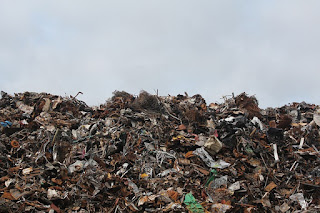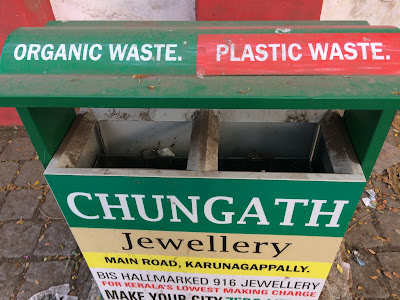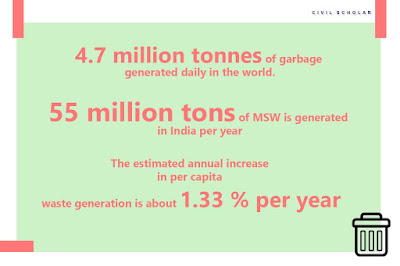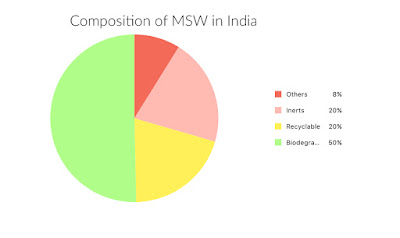Experts accounted that about 50 percent of the waste generated in Delhi can be disposed as compost. Not just Delhi, every major city of India generates waste which can be efficiently disposed if collected and segregated properly.
The civic corporation’s chairman Naresh Kumar announced while presenting its annual budget of 2017-18 that five NDMC localities — Jor Bagh, Pandara Park, Bapa Nagar, Kaka Nagar and Golf Links — will be made zero waste colonies. In a zero waste colony, garbage is segregated into wet waste, dry waste and e-waste. Wet waste is then put in compost pits and e-waste sent to a recycle centre. The rag pickers will collect all the recyclable items from dry waste and the rest will go to the landfill site. This kind of waste segregation reduces the burden on landfill sites.
MSW (Municipal Solid Waste generation in India)
As per estimates more than 55 million tons of MSW is generated in India per year; the yearly increase is estimated to be about 5%. It is estimated that solid waste generated in small, medium and large cities and towns in India is about 0.1 kg, 0.3 – 0.4 kg and 0.5 kg per capita per day respectively. The estimated annual increase in per capita waste generation is about 1.33 % per year.
In some cities like Mumbai, Chennai, Delhi, Bengaluru, Hyderabad and Ahmedabad garbage disposal is done by Public Private Partnerships (PPPs). The private sector has been involved in door-to-door collection of solid waste, street sweeping (in a limited way), secondary storage and transportation and for treatment and disposal of waste.
Urban Local Bodies spend around Rs.500 to Rs.1500 per ton on solid waste management of which, 60-70% of the amount is on collection alone, 20% - 30% on transportation, but hardly any fund is spent on treatment and disposal of waste.
e-Waste
It is reported that in India about 800,000 MT of e-waste is generated annually.
With the rapid increase of cellular technology in the past decade, India has become the fifth largest producer of eWaste in the world. A study says that “India has surely emerged as the second largest mobile market with 1.03 billion subscribers, but also the fifth largest producer of e-waste in the world, discarding roughly 18.5 lakh metric tonnes of electronic waste each year, with telecom equipment alone accounting for 12 per cent of the e-waste.”
There are only two sectors which carry out e-waste recycling process formally in India. These facilities are M/s. Trishiraya recycling facility, Chennai and M/s. E-Parisara, Bengaluru. There is no large-scale organized e-waste recycling facility in India, and thus the recycling exists in un-organized sector.
The maximum e-waste treatment is being carried out in an unregulated environment, where there is no control on emission of toxic material.
Sources: Hindusthantimes, The Hindu, IJOEM
 |
| image: pixabay |
The civic corporation’s chairman Naresh Kumar announced while presenting its annual budget of 2017-18 that five NDMC localities — Jor Bagh, Pandara Park, Bapa Nagar, Kaka Nagar and Golf Links — will be made zero waste colonies. In a zero waste colony, garbage is segregated into wet waste, dry waste and e-waste. Wet waste is then put in compost pits and e-waste sent to a recycle centre. The rag pickers will collect all the recyclable items from dry waste and the rest will go to the landfill site. This kind of waste segregation reduces the burden on landfill sites.
MSW (Municipal Solid Waste generation in India)
As per estimates more than 55 million tons of MSW is generated in India per year; the yearly increase is estimated to be about 5%. It is estimated that solid waste generated in small, medium and large cities and towns in India is about 0.1 kg, 0.3 – 0.4 kg and 0.5 kg per capita per day respectively. The estimated annual increase in per capita waste generation is about 1.33 % per year.
 |
| A dust bin with separation for organic and plastic waste in Kochi image: CS |
 |
| illustration: CS |
In some cities like Mumbai, Chennai, Delhi, Bengaluru, Hyderabad and Ahmedabad garbage disposal is done by Public Private Partnerships (PPPs). The private sector has been involved in door-to-door collection of solid waste, street sweeping (in a limited way), secondary storage and transportation and for treatment and disposal of waste.
Urban Local Bodies spend around Rs.500 to Rs.1500 per ton on solid waste management of which, 60-70% of the amount is on collection alone, 20% - 30% on transportation, but hardly any fund is spent on treatment and disposal of waste.
e-Waste
It is reported that in India about 800,000 MT of e-waste is generated annually.
 |
| illustration: CS |
 |
| image: IJOEM |
There are only two sectors which carry out e-waste recycling process formally in India. These facilities are M/s. Trishiraya recycling facility, Chennai and M/s. E-Parisara, Bengaluru. There is no large-scale organized e-waste recycling facility in India, and thus the recycling exists in un-organized sector.
The maximum e-waste treatment is being carried out in an unregulated environment, where there is no control on emission of toxic material.
Sources: Hindusthantimes, The Hindu, IJOEM